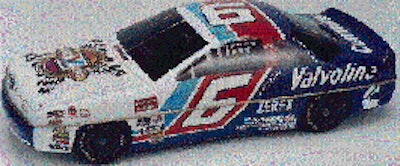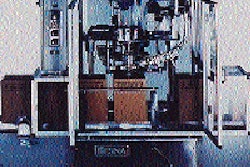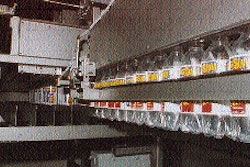Automotive designers, spurred by Japanese car builders, have dramatically changed the art of metal forming into the pleasing, aerodynamic cars we see today. Similarly, the art and science of metal forming for containers has been taken to a new level by J. L. Clark Co. (Rockford, IL). Its demonstration is also automotive. The product is a promotional tin for Valvoline® Oil Co., Lexington, KY, a unit of Ashland Oil. The two-piece tin is the brainchild of Rod Taylor of the Optimum Group (Cincinnati, OH), a sales promotion company working for Valvoline. Optimum was developing a collector card promotion, based on a "100 Years of Racing" theme, and it wanted a souvenir container to deliver the cards in a memorable way. The idea was to create a tin card container modeled on the Valvoline NASCAR race car of driver Mark Martin. The tin and cards are available to consumers for $12.95 with the purchase of a case of motor oil or an oil change using Valvoline. Taylor's idea to create a car collectible tin excited Valvoline's marketing people-but not the container makers he contacted. "All the tin manufacturers we approached turned us down, saying that what we wanted was impossible," Taylor recalls. Until J. L. Clark was contacted. Unusual shapes and distortion printing of metal sheet is not terribly new. However, to achieve what Optimum/Valvoline expected was well beyond what had been done before. "Normally you form the body, seam on the bottom and stamp out the lid and curl the edges," says Roy Robinson, vice president of marketing at Clark. For this car-can, there are nine separate forming molds. Clark got together with partners, Gerhard Designing and Mfg. (Burbank, IL) and Widen Colorgraphics (Madison, WI) last fall, recognizing that Valvoline needed samples for the start of the racing season in March. "Without the commitment from Widen and Gerhard, we couldn't have achieved this," points out Ron Moreau, Clark president. "From the outset, we had to break through some technology barriers that have hampered the promotional can market and the stamping of metal parts. This isn't even close to traditional tool making or can forming." Twice the steps This project involved about two and one-half times the number of forming steps that are used for even an unconventional metal tin, Moreau says. Between the three companies, some $500ꯠ was invested in molds and new equipment. Even Widen, the color separator for Clark, added new software to be able to produce the predictable art distortions that are necessary for good reproduction in the finished part. "We do distortion printing now, but not nearly to the degree that this shape demanded," says Robinson. "Widen added some software programs that would help them anticipate the art distortion from bending and shaping the metal. Even so, we still went through about four separate trials of printing sheets then stamping them out to revise the graphics and dot patterns to compensate for the draw. With this container, we have a three-dimensional form with multiple draws and radii to plan for." Clark prints the sheet offset in four process colors. According to Gerhard Haigis, president of Gerhard Designing, making the molds was the most difficult part of the project. "Making the molds was extremely difficult," he says. "We didn't even have a drawing or model to work from. The hardest part of this for us was to put the concept into design steps. That's why so much of this project was engineering." Along with the mold sets and the computerized program, special machinery was used by both Gerhard and by J. L. Clark, all part of the overall investment. In fact, Robinson says, virtually no existing forming equipment was used for this project. Investing in the future Even at a half-million dollars in investment, that doesn't begin to cover all of the effort that went into making the car-can a reality. "In this kind of venture, you learn more than you had planned," Robinson says. "Even with Valvoline offering these for about $13 each, all the participants have invested more than they'll get out of this project." Or as Moreau puts it, "if you want to be the leader,you have to have a lot of value added. We want to stay the leader." Clark expects that while the Valvoline production run may have been completed, there could be other NASCAR designs for the company. Even more important, though, the technical expertise opens the door for many other unusual shapes, for example, a two-piece promotional tin shaped like a camera, says Robinson. "We took a lot of risks upfront on costs," recalls Moreau. "But we decided we were going to develop a technology breakthrough. That was prominent in our decision from the start."






















